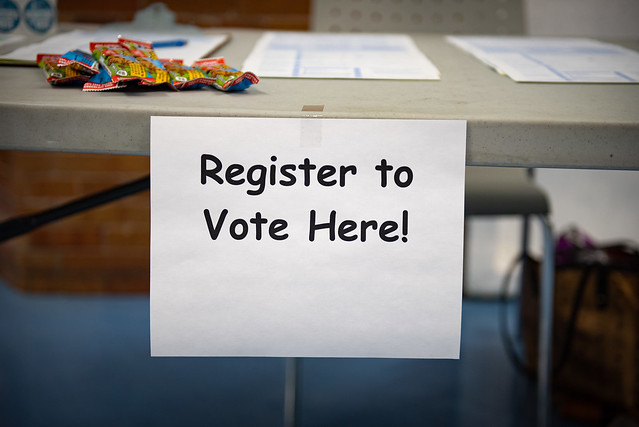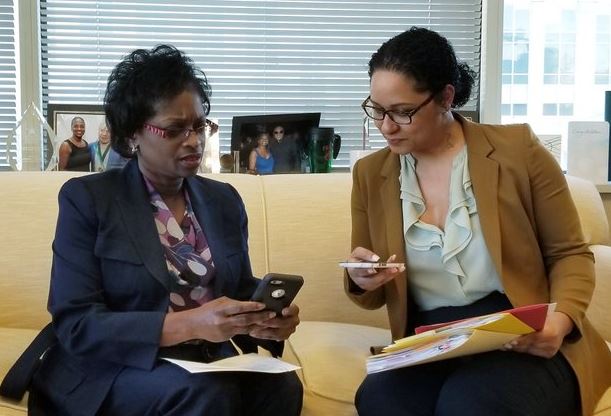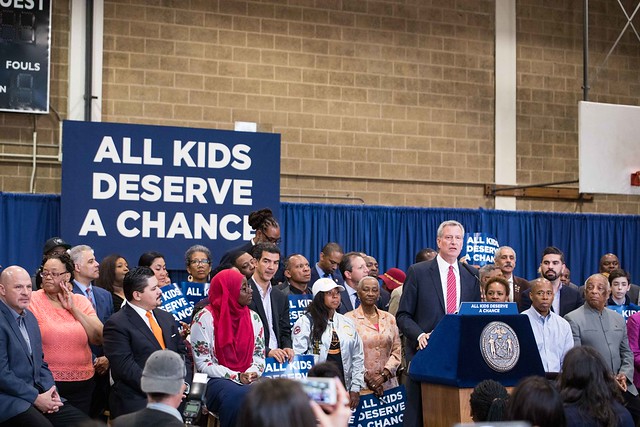We Can Help Thousands More Residents of Affordable Housing Register to Vote

(photo: Michael Appleton/Mayoral Photography Office)
No one’s socioeconomic status should limit their capacity to make their voice heard at the ballot box. But more must be done to ensure that low-income populations across the nation are registered to vote and can participate in the democratic process.
We can help address this issue in New York by taking more information directly to residents in and around their own apartment buildings. Managers of affordable housing developments can play a significant role in connecting tenants with the information needed to register to vote.
That is why NYSAFAH is launching a non-partisan voter registration initiative that will target residents of affordable housing developments that are managed by our members. Through this effort, we can help thousands more low-income New Yorkers register to vote by the end of this year.
NYSAFAH is the state’s trade association of affordable housing developers, managers, architects, planners, and others who help build and preserve homes for low- and middle-income New Yorkers.
Our first priority is to deliver quality housing for New Yorkers. However, being good stewards of affordable housing often extends beyond the day-to-day maintenance of four walls and a roof.
Our members also impact the lives of their residents by helping them access social services, participate in recreational programming and engage in other activities that contribute to strong families and healthy living. We believe that working to increase rates of voter registration can become an important part of that broader mission.
As part of our new initiative, NYSAFAH will partner with the New York City League of Women Voters to advance a coordinated outreach campaign that is driven by direct engagement with residents. This outreach will include voter registration drives held at buildings in which residents live. At these sessions, managers will provide non-partisan guidance and information with the goal of maximizing voter registration among the resident population.
NYSAFAH members collectively manage hundreds of buildings across the five boroughs, with tens of thousands of residents overall. This makes for an even greater opportunity to have a real impact on boosting rates of voter registration among low-income communities throughout New York.
As we make progress on this front, we will also be taking an important first step toward advancing the broader goal of increasing voter participation – when more of us vote, we all benefit from a stronger democracy.
And after all, this just makes sense. When it comes to engaging with residents, why not start with a renewed effort to give them more of the tools they need right at home?
We have already received a great deal of positive feedback from NYSAFAH members who are excited to embark on what we all believe will be a crucial initiative for our state. Our team looks forward to seeing thousands more New Yorkers registered to vote – and we hope that this work can serve as a model for future initiatives to keep advancing the ball.
***
Jolie Milstein is president and CEO of the New York State Association for Affordable Housing (NYSAFAH). On Twitter @NYSAFAH.
***
Have an op-ed idea or submission for Gotham Gazette? Email This email address is being protected from spambots. You need JavaScript enabled to view it.
T-Mobile-Sprint Merger Will Help Those Who’ve Been Left Behind in the Digital Age

Mignon Clyburn, the author, left (photo: @MignonClyburn)
Wireless broadband should reach communities of color at the same time it reaches most of the U.S. population.
Why do I say this…or is the question really, why am I still saying this in 2019?
While serving nine years as a Federal Communications Commissioner, I saw firsthand how wireless broadband access expands access to jobs, enriches education, and deepens political engagement. Losing out on wireless broadband opportunities today increases the risk of us losing out on just about everything the future holds.
In a recent roundtable discussion at New York Law School about “5G,” the next generation of wireless technology, I spoke about how both government and industry need to keenly focus on ensuring that underserved communities receive the anticipated benefits of 5G sooner rather than later. And, in my view, approving the T-Mobile/Sprint merger is one of the best ways to ensure inclusive broadband deployments.
T-Mobile, which I am currently advising, has long been an ally of underserved consumers. You find their stores in markets other providers avoid, and the company has doubled down and broadened access to key communications and technological services.
Consider T-Mobile's investments in MetroPCS, the prepaid brand it acquired in 2013, and you will find an unwavering commitment to cost-conscious communities. And that's not all—T-Mobile has helped hundreds of thousands of Americans, including thousands of New Yorkers, build a credit history by enabling, and in many cases encouraging, a transition from prepaid to postpaid phone plans. T-Mobile has bridged the gap between Metro and postpaid phone plans, allowing Metro customers to have a comparable experience to those on postpaid plans.
The merger with Sprint will enable a massive new investment by T-Mobile—nearly $40 billion, to be exact—to create an inclusive, nationwide 5G network and services that will greatly improve access to broadband for all New Yorkers, not just the wealthy.
In my time at the FCC, I worked on expanding wireless service in underserved neighborhoods because I recognized early on that broadband connectivity offers an ever-present stepping stone for upward mobility. Now in 2011, I opposed the proposed AT&T/T-Mobile merger, in part because AT&T already controlled 44 percent of the market. But unlike that deal, the T-Mobile/Sprint merger will combine the two smallest nationwide providers and strengthen a maverick that can better compete against two dominant players.
From Bed-Stuy to Buffalo, the combined company’s expansive deployment plan promises to bring us closer to bridging the digital divide, and it will do so in an affordable way.
The companies have pledged to offer the same services T-Mobile and Sprint currently offer at the same prices for three years or until better plans that offer lower prices or more data are made available. This means that competition will quickly heat up and prices will likely come down as other carriers feel the heat.
No one stands to benefit more from this fierce competition than those currently underserved. Research, including the work of Brookings Institution expert Nicol Turner Lee, shows that lower-income Americans are the most likely to rely on wireless as their primary or sole means of connecting to the internet. The 5G network enabled by the T-Mobile/Sprint merger will allow customers who can’t afford expensive in-home broadband to access broadband-equivalent speeds on their phones.
While at the FCC, I was proud to have strengthened the Lifeline program, which subsidizes wireless service for those who otherwise could not afford it. T-Mobile and Sprint have not only committed to continue supporting this important service in New York and across the country, but they will also maintain support for programs like Sprint's 1Million Project, which provides service and devices to worthy high school students.
The New York Public Service Commission has already approved the merger of T-Mobile and Sprint, and I hope that those who are still reviewing the transaction at the federal and state levels will not stand in the way.
The status quo is not acceptable. What is needed is for a proven wireless industry disruptor to expand on a larger scale, bringing wider and better connectivity opportunities to New Yorkers as we move into the 5G era. For those currently on the wrong side of the digital divide, change cannot come soon enough.
***
Mignon Clyburn served as Federal Communications Commission Commissioner from 2009 to 2018, and is currently an adviser to T-Mobile. On Twitter @MignonClyburn.
***
Have an op-ed idea or submission for Gotham Gazette? Email This email address is being protected from spambots. You need JavaScript enabled to view it.
Social Workers for Homeless Kids is Not the Place to Skimp

(photo: Benjamin Kanter/Mayoral Photo Office)
Last year, nearly 38,000 New York City students arrived in the classroom having woken up in a shelter. That’s more students than the total enrollment of the Buffalo public schools, the next largest school district in the state.
Many had been exposed to domestic violence, one of the driving forces of homelessness. Many were forced to transfer schools mid-year, some multiple times, after being placed in a shelter in an entirely different borough. Some were in placements with no kitchen or laundry machine. More than half missed the equivalent of an entire month of the school year due to absences.
Imagine being dropped abruptly mid-year into a classroom where you know no one and have to get used to a new school—all while wondering how long your family will have to stay in a shelter. Imagine having 50 students in this situation—two full kindergarten classrooms of children—come into your school every day, and not having any additional staff to focus on supporting them.
For many students and schools, this is reality.
As the number of children experiencing homelessness has skyrocketed, it is essential that schools serving large numbers of students living in shelter have trained professionals dedicated to meeting their needs.
Three years ago, Mayor de Blasio launched a program to place 33 “Bridging the Gap” social workers in schools with high concentrations of students living in shelter. This year, with additional funding from the mayor and the City Council, there are 69 Bridging the Gap social workers. These social workers provide much-needed counseling to address the trauma that can interfere with the school performance of students living in shelters and work to address barriers to regular school attendance.
However, far too many schools still lack this critical support. In fact, 100 schools have 50 or more students living in shelter and no Bridging the Gap social worker.
We were baffled that, for the third year, instead of increasing funding for Bridging the Gap social workers, Mayor de Blasio omitted all funding for this program from his preliminary budget, jeopardizing its continuation.
Following an outcry from Council members and advocates, the mayor restored funding for 53 of the 69 social workers in his executive budget last month. While we were pleased that the mayor included long-term (“baselined”) funding for the 53 social workers, ending the annual budget dance, we were disheartened that 16 social workers remained at risk, especially when we need even more than 69.
Following further criticism, the administration announced that it would restore funding for the remaining 16 social workers just before the City Council began its executive budget hearings last week.
The administration has cited the restoration of the Bridging the Gap social workers as a key way that it has been responsive to the Council’s priorities. But the Council has asked for an increase—not merely a restoration—of the program.
In fact, 35 Council members, as well as shelter providers and education advocates, have called on the mayor to add $5 million to the budget to increase the number of Bridging the Gap social workers from 69 to at least 100.
Cutting funding for the program and then restoring it should not be viewed as a victory when thousands of students living in shelter lack access to the crucial help Bridging the Gap social workers can provide.
Schools alone cannot end homelessness. But, with the right support, schools can transform the lives of students who are homeless. As Mayor de Blasio has stated, a quality education is “the most powerful tool we know for lifting one’s life chances.”
To break the cycle of homelessness, the city must devote more attention and resources to the education of students living in shelter. The mayor should start by providing funding for at least 100 school social workers for students living in shelter in this year’s budget.
***
Kim Sweet is Executive Director of Advocates for Children of New York. On Twitter @AFCNewYork.
***
Have an op-ed idea or submission for Gotham Gazette? Email This email address is being protected from spambots. You need JavaScript enabled to view it.




